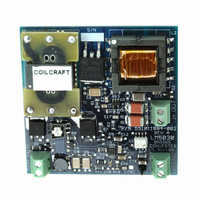LM5030EVAL National Semiconductor, LM5030EVAL Datasheet

LM5030EVAL
Specifications of LM5030EVAL
Related parts for LM5030EVAL
LM5030EVAL Summary of contents
Page 1
... LM5030 Evaluation Board Introduction The LM5030EVAL evaluation board provides the design en- gineer with a fully functional push-pull power converter using the LM5030 PWM controller. The performance of the board is as follows: • Input range: 36V to 75V • Output voltage: 3.3V • Output current 10A • ...
Page 2
Board Layout and Probing Board Connections/Start-Up The input connection to the board from a power supply is made to connector J1. The power supply must be capable of supplying not only the current during normal operation, but also the inrush ...
Page 3
Performance (Continued) current, the output will be regulated to within the input voltage is varied over its range (36 - 75V). The power conversion efficiency is shown in Figure 3. Waveforms If the circuit ...
Page 4
FIGURE 3. Efficiency vs Load Current and V 4 20089203 IN ...
Page 5
OUT 36V 1.0A 2.2µS 5.3µS 266.7 48V 10A 1.9µS 5.5µS 270.3 75V 1.0A 1.2µS 6.2µS 270 10.5V 36V 72V 90V 10V 11.5V 48V 96V 130V 18V 10.5V 75V 150V ...
Page 6
FIGURE 6. Average Voltage at the CS pin vs Input Current www.national.com FIGURE 5. V Voltage vs Load Current CC 20089206 6 20089205 ...
Page 7
7 www.national.com ...
Page 8
... Q1, 2 SUD19N20-90 J1-3 651-1727010 Note 1: Data sheets for L1, L2, and T1 are available from Coilcraft at http://www.coi1craft.com/prod_pwr.cfm. Select “Magnetics for National Semiconductor 100V Push-Pull Current Mode PWM Controller, LM5030”. Note 2: Data sheet for T2 is available from Pulse Engineering at http://www.pulseeng.com/default.cfm. www.national.com ...
Page 9
PCB Layout Diagrams FIGURE 8. Bottom Layer (viewed from top) 9 20089208 www.national.com ...
Page 10
PCB Layout Diagrams www.national.com (Continued) FIGURE 9. Top Silk Screen 10 20089209 ...
Page 11
... BANNED SUBSTANCE COMPLIANCE National Semiconductor certifies that the products and packing materials meet the provisions of the Customer Products Stewardship Specification (CSP-9-111C2) and the Banned Substances and Materials of Interest Specification (CSP-9-111S2) and contain no ‘‘Banned Substances’’ as defined in CSP-9-111S2. ...










